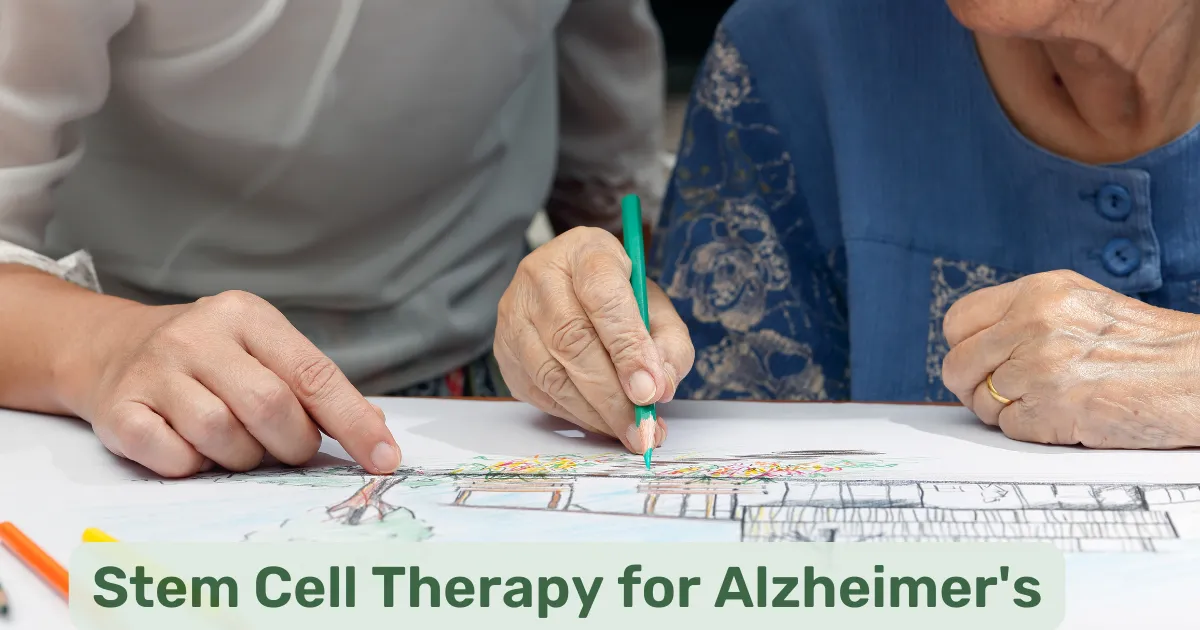Stem Cell Therapy For Alzheimer’s: Alzheimer’s disease is a progressive neurodegenerative disorder characterized by the accumulation of abnormal protein deposits (amyloid plaques and tau tangles) in the brain. These pathological changes lead to the loss of neurons and synapses, resulting in cognitive decline, memory impairment, and ultimately, dementia.
Explanation and Its Potential in Treating Neurodegenerative Diseases
Stem cell therapy holds immense potential in addressing neurodegenerative diseases like Alzheimer’s. The key lies in stem cells’ unique ability to replace damaged or lost neurons and promote neural repair. Neural regeneration is a complex process, and stem cells can contribute in several ways.
Firstly, stem cells can differentiate into various cell types, including neurons. This means they can replace the neurons that are damaged or degenerating in Alzheimer’s patients. By generating new, functional neurons, stem cell therapy aims to restore lost cognitive function and memory.
Secondly, stem cells release neurotrophic factors and other bioactive molecules that support the survival and health of existing neurons. This neuroprotective effect can slow down the progression of the disease and potentially halt further cognitive decline.
Additionally, stem cells exhibit anti-inflammatory properties. In Alzheimer’s, neuroinflammation plays a significant role in exacerbating neuronal damage. Stem cells can modulate the immune response, reducing harmful inflammation and creating a more conducive environment for neuronal repair.
Moreover, there’s evidence to suggest that stem cells can aid in the clearance of amyloid plaques, one of the hallmark features of Alzheimer’s disease. By assisting in the removal of these toxic protein deposits, stem cell therapy can potentially alleviate some of the pathological burden on the brain.
Challenges and Limitations in Implementing Stem Cell Therapy for Alzheimer’s
While stem cell therapy for Alzheimer’s holds great promise, several challenges and limitations must be addressed. One major challenge is optimizing the delivery of stem cells to the brain. Stem cells need to be transplanted precisely into the regions of the brain affected by Alzheimer’s to ensure their effectiveness.
Long-term safety is another concern. There is a risk of uncontrolled cell growth, potentially leading to tumors. Researchers are diligently working on refining the safety of stem cell therapies to minimize these risks.
Immune rejection is also an issue, as the recipient’s immune system may recognize transplanted cells as foreign invaders. To counter this, researchers are developing strategies to make stem cells less immunogenic or exploring the use of patient-specific iPSCs.
Achieving functional integration of transplanted cells into the existing neural networks is a significant hurdle. For stem cell therapy to be truly effective, the new neurons need to form connections and participate in brain functions seamlessly.
Furthermore, ethical concerns still linger, particularly regarding the use of embryonic stem cells (ESCs). Ethical guidelines and regulations are in place to navigate these issues, but they continue to be debated.
Despite these challenges, the remarkable progress in stem cell research, coupled with ongoing clinical trials and multidisciplinary collaboration, instills hope that these obstacles will be overcome as stem cell therapy for Alzheimer’s matures into a viable treatment option.
Future Prospects and Potential Directions
The future of stem cell therapy for Alzheimer’s disease is both promising and dynamic. Researchers are exploring various avenues to enhance the effectiveness of this treatment and address its current limitations.
Precision Medicine: One exciting prospect involves tailoring stem cell therapies to individual patients. This approach, known as precision medicine, utilizes patient-specific induced pluripotent stem cells (iPSCs). By deriving stem cells from a patient’s own cells, the risk of immune rejection is minimized, and treatment becomes highly personalized.
Combination Therapies: Scientists are investigating the synergy between stem cell therapy and other treatment modalities. Combinations with emerging technologies like gene editing, neuroprotective drugs, and immune-modulating agents hold the potential for more robust outcomes.
Optimizing Delivery: Researchers are refining methods for delivering stem cells into the brain. Innovative techniques, such as microinjections and nanotechnology-based approaches, aim to improve the precision and efficiency of cell transplantation.
Biomaterial Scaffolds: Biomaterials are being explored as scaffolds to support the survival and integration of transplanted stem cells. These scaffolds create a conducive environment for stem cell differentiation and neuronal integration, further improving therapeutic outcomes.
Monitoring and Imaging: Advancements in neuroimaging techniques are facilitating real-time tracking of transplanted stem cells’ behavior within the brain. This allows researchers to monitor their integration and functional contribution accurately.
Stem Cell Therapy for Alzheimer’s: Comparison with Other Treatment Approaches
Comparing stem cell therapy with other treatment approaches for Alzheimer’s highlights its unique advantages and potential drawbacks.
Drug Therapies: Conventional drug therapies for Alzheimer’s primarily target symptom management and may have limited disease-modifying effects. In contrast, stem cell therapy aims at neuroregeneration and addressing the root causes of the disease.
Lifestyle Interventions: Lifestyle modifications, including diet and exercise, play a crucial role in Alzheimer’s prevention and management. However, once the disease has progressed significantly, the impact of lifestyle changes may be limited.
Immunotherapy: Immunotherapies targeting amyloid plaques are in development, but their long-term efficacy and safety are still under investigation. Stem cell therapy offers a different approach by replacing damaged neurons.
Combination Approaches: The future may see a convergence of therapies, with stem cell treatment used alongside drug therapies and lifestyle interventions for a more comprehensive approach to Alzheimer’s management.
Ethical Considerations: Stem cell therapy, particularly when using embryonic stem cells, raises ethical concerns that other treatment approaches may not. These ethical considerations may influence the choice of treatment.
Side Effects and Long-term Outcomes
Stem cell therapy for Alzheimer’s, like any medical intervention, carries potential side effects and long-term considerations.
Tumor Formation: The risk of uncontrolled cell growth leading to tumor formation is a primary concern. Rigorous safety measures are being implemented to minimize this risk, but it remains a crucial consideration.
Immunogenicity: Immune reactions against transplanted cells can occur, leading to graft rejection. Patient-specific iPSCs aim to mitigate this issue.
Integration Challenges: The long-term integration of transplanted cells into existing neural networks is an ongoing challenge. Ensuring these cells effectively participate in brain functions remains a key focus.
Ethical and Regulatory Issues: Ethical concerns surrounding the use of certain stem cell types, such as embryonic stem cells, continue to influence the therapy’s development and implementation.
Long-term Monitoring: Long-term outcomes and the durability of cognitive improvements require extended follow-up and monitoring in clinical trials to assess the therapy’s true effectiveness.
As research advances and technology evolves, addressing these challenges and optimizing the benefits of stem cell therapy for Alzheimer’s disease remains at the forefront of scientific endeavors.



Pingback: How Alzheimer's Disease Affects Women Differently From Men